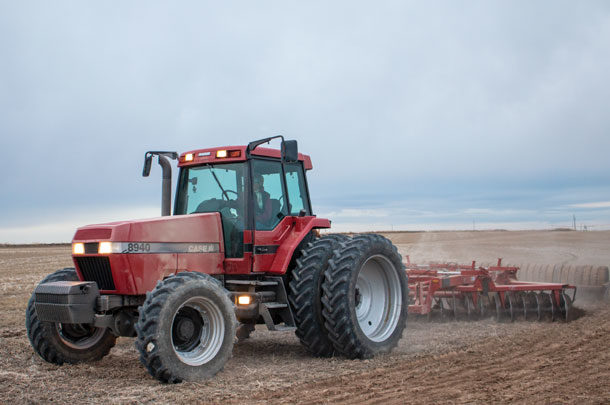Engine fuel efficiency generally improves as engine designers continually investigate effects of fuel injection timing, turbulence of fuel and air mixing in the combustion chamber, engine operating temperatures and other factors that can affect conversion of diesel into mechanical energy. “Bare” engine fuel efficiency over longer periods of time improves at an average annual rate of perhaps 1% per year as a result of engine design combustion improvements.
Unfortunately, although combustion efficiency improves, we are also continuously adding more requests for power (i.e., engine “load”) to engines on board tractors, combines and other self-propelled equipment. Larger cabs with additional glass for visibility create greater cooling load for engine-powered air conditioning systems. Demand for greater hydraulic power (flow rates and pressure) requires additional engine power. Cleaner engine exhaust emission (e.g., Tier 4 technology) requires power to operate the emissions system. Onboard accessories requiring engine power continue to increase over time, as exemplified by electrical power demands for monitors, sensors and electric motors on equipment (e.g., fans and seed drives on planters).
These increasing demands for engine power subtract from gains in bare engine efficiency so that the actual annual change in fuel economy is closer to about 0.25% per year as measured by tractor fuel economy tests over longer time periods of 10 to 20 years. Using this value, ag equipment fuel efficiency may increase about 5% to 6% when comparing new equipment to 20- to 25-year-old equipment. Of course, specific individual equipment could have more (or less) change.
In many cases, fuel used for field operations is impacted more by how the equipment is operated rather than how new the equipment is. Field measurements by Iowa State University (ISU) showed a 25% reduction in fuel use for lighter drawbar loads by reducing engine speed and shifting to a higher transmission gear (“shift-up, throttle-back” technique). Tractors used in field operations often require less than 100% of available tractor power, making this a useful strategy. Those using onboard “cruise control” systems on some newer tractors, which automatically adjust engine and transmission speed for a specific drawbar load at a given travel speed, already are using this technique and may have noticed reduced engine rotations per minute (rpm) relative to what they previously used with a manual transmission.
Energy required for tilling is directly related to tillage depth. The same ISU field study measured 28% less fuel use when shallower tillage depth settings were used with the same implement. Tilling no deeper than a desired depth to loosen soil and break up compaction saves fuel as well as time and wear on equipment.
More importantly, skipping an unnecessary tillage trip saves 100% of the fuel required for that field operation. Row crop farmers need to plant, harvest and control weeds (usually by spraying). The number and depth of tillage operations varies with operator and field conditions, and in some cases may be optional (e.g., using a strip-till or even no-till system). Approximately 2 to 2.5 gallons per acre of diesel is required to plant, spray and harvest corn grain and soybeans, but an additional 2 to 3 gallons per acre may be used for tillage operations (Figure 1).

The number of field passes made may also be reduced by making sure equipment such as planters, seeders and applicators (fertilizer and pesticide) are appropriately calibrated to avoid the need for a second pass for replanting or reapplication. Consider combining field passes such as applying fertilizer with a tillage or planting operation.
A major energy requirement of wet forage harvest is cutting of stalks, stems and other plant material. Keeping knives sharp and in close tolerance with shear bars improves fuel efficiency. Cut forage pieces only as short as needed for good packing. Because balers require maintaining tractor engine speed for specific power take-off (PTO) shaft speed, the shift-up, throttle-back technique is not an option when using this or other PTO-operated equipment such as a manure spreader (unless PTO speed can be decoupled from engine speed).
Simply adhering to good air and fuel filter maintenance and staying on a filter replacement schedule for an engine can add 3% to 4% fuel savings. For livestock producers and others using tractors during cold weather, an engine block heater is often manually plugged in overnight. A low-cost timer with adequate current capacity for the engine heater (e.g., timers used for swimming pool pumps) can be used to warm the engine for just a couple of hours before start-up, paying for itself in two months or less depending on heater size and amount of time used.
When purchasing a new or used tractor, use Organization for Economic Cooperation and Development (OECD or “Nebraska”) tractor tests to help compare fuel economy (see Iowa State University Extension bulletin Fuel efficiency factors for tractor selection, PM 2089O, for details). Newer technology, such as the use of autosteering to avoid swath overlap, can help avoid excessive passes in the field.
In summary, when possible, take advantage of the fuel efficiency of newer equipment. Keep in mind, however, that how the equipment is operated and maintained makes more difference in most cases than age of equipment. Most fuel savings are still more closely related to the way the tractor is used (e.g., engine speed, gear combination; tillage depth; maintenance etc.) rather than tractor age. Although fuel is not the most costly input for crop production, it is often the easiest input to manage by reducing its use to improve profit margins. ![]()
Mark Hanna is a agricultural engineer at Iowa State University Extension (retired) Email Mark Hanna.










